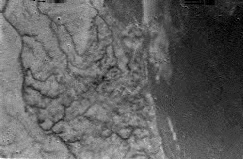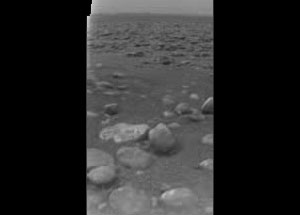
The joint Cassini-Huygens has launched the probe Huygens to the surface of Saturn's moon Titan. Cassini continues to orbit relaying information being sent from the probe on the surface back to Earth.
It's really quite incredible when you think about it. Not only were these craft made out of melted down rocks, sand and oil (rocks for the metal, sand for the electronics and oil for the plastics) but it was then put together, launched, directed to a distant planet's moon. From there it was directed to drop this payload which managed to land from space [see descent image to the right] without being damaged, send images via radio waves through the moons atmosphere to be received by the circling Cassini and relayed to earth all with pinpoint accuracy otherwise the signals would be lost. It's fascinating and incredible.
 The signals from Titan take just over an hour to reach Earth. They expect to get 20 panorama images, but could receive more. The first image from the surface [see image on the left] shows a barren rock strewn surface that looks like some of those from the Mars probe since they are in black and white.
The signals from Titan take just over an hour to reach Earth. They expect to get 20 panorama images, but could receive more. The first image from the surface [see image on the left] shows a barren rock strewn surface that looks like some of those from the Mars probe since they are in black and white.
Space.com
The first pictures revealing the surface of Saturn's moon, Titan, were shown from Europe's Huygens probe, showing what look like drainage channels on the surface of what until today has been a planet totally hidden from view.
...
The image appears to show ravines that could have been carved by the liquid hydrocarbons thought to cover much of Titan's surface. The ravines, stubby drainage-like channels, appeared to funnel toward what appeared to be a shoreline, researchers said during their initial reactions to the image.
"If it's not a sea, it appears to be a lake of tar-like material," said John Zarnecky, principal investigator for the Huygens' Surface Science Package, which is taking data from the surface of Titan.
Zarnecky said the 350 images taken by Huygens of Titan's surface were only about half the anticipated photographic harvest researchers were expecting.
Huygens was originally expected to send more than 700 pictures taken during its 2.5-hour descent to the Titan surface, but one of the two communications channels on the satellite apparently malfunctioned, cutting by about half the number of images received by NASA's orbiting Cassini satellite and relayed to mission control here.
NASA Cassini-Huygens Mission Main Page
Other Commentary:
California Yankee
Speed of Thought who has become space-blog-boy and also has some information on a strange rock found on Mars
Right Thinking From The Left Coast who asks:
If the project is a joint US/European venture, yet it’s run by JPL, was designed by JPL, and the imaging team is in Arizona, what did Europe and Italy do?
Say Anything who mentions Titans high Methane content atmosphere and pontificates on the reasons it may be so high.
There are ways of creating methane, but the majority of the know ways for making methane involve a biologic process. We know that asteroids can contain methane locked in ice, but methane breaks down in the presence of sunlight, so for Titan to have such a large abundance of Methane, either it’s being continually bombarded by asteroids containing methane, or there’s a biologic processes on the planetoid, or there’s a differing method of producing methane.
Intriguing indeed!
The Command Post

